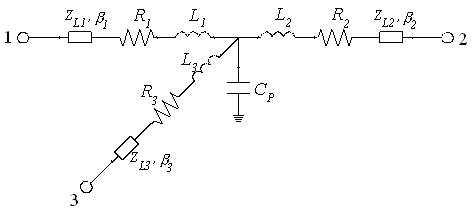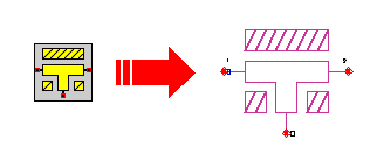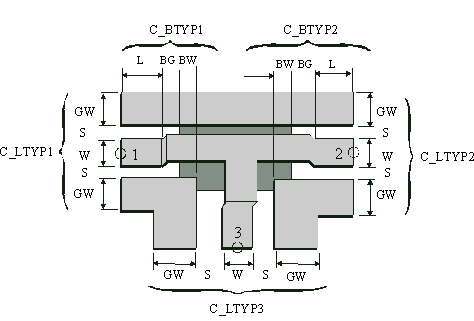The C_TEE module represents a junction between three coplanar lines. The dimensions of lines are defined using data items addressed by C_ LTYP1 to C_LTYP3 (see C_LINTYP in chapter 4). The dimensions of the air-bridges at ports are defined in data items addressed by C_BTYP1 to C_BTYP3(see CAIRTYP in chapter 4).
If lines defined by C_LTYP1 to C_LTYP3 have different levels (CEN_MET) an inter metal via is automatically included in the tee structure.
For a Tee-junction without air-bridges, the applied line types must have the same CEN_MET and GND_MET.
The keyword TYPE of the respective C_BTYP data item controls if the structure contains bridges or not. Normally bridges are necessary to suppress odd mode excitation. Note that due to the applied air bridge additional feed lines with a length defined in the respective C_BTYP data item are connected to the Tee-junction structure. This additional feed line connects the reference plane with bridge. There is no line between bridge and Tee-junction itself (see Illustration).
The keyword TYPE of the bridge applied at each port and the center line level CEN_MET of the line type applied on the same port can not have the same value. If the Keyword TYPE in one of the C_BTYP data items is set to -1, the TYPE of the other C_BTYP data items have also to be -1.
All C_BTYPs must have the same DIE_IDX.
If the Keyword TYPE in one of the C_BTYP data items is set to 0 and the parameter BG and BW are nonzero values, these parameter will not set automatically to zero. This means that the total size of the discontinuity is not changed if only the TYPE is set to zero (see Layout).
If L1 and L2 in selected C_GRID are not set to -1 (auto sizing), the minimum values for L1 and L2 are:
L1min= W3+2*S3+2*max(GW3, max(BW1+BG1, BW2+BG2) +4*DL{C_GRID})
L2min= max(W1+2*S1, W2+2*S2) + 2*max(max(GW1,GW2), BW3+BG3+4*DL{C_GRID})
See notations in chapter 4 (Important Note!) for the correct selection of the C_LTYP and C_BTYP.



